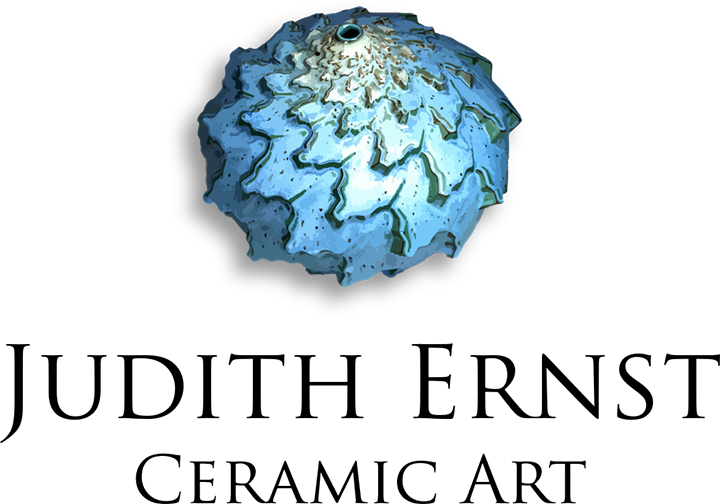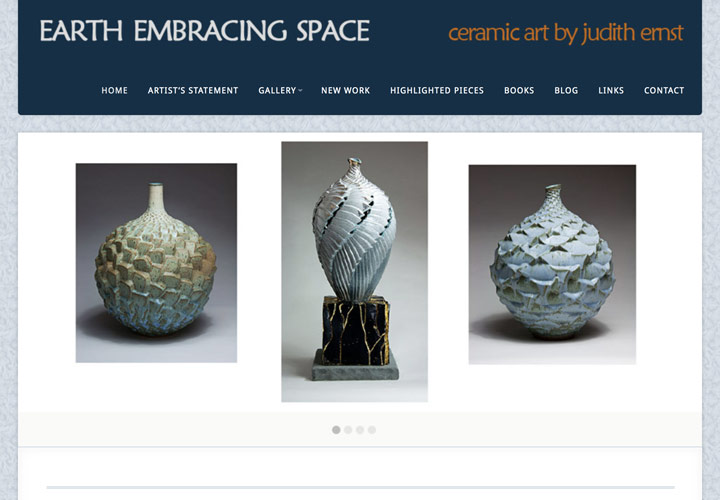Welcome to my new, improved website, Earth Embracing Space: Ceramic Art by Judith Ernst! Having…
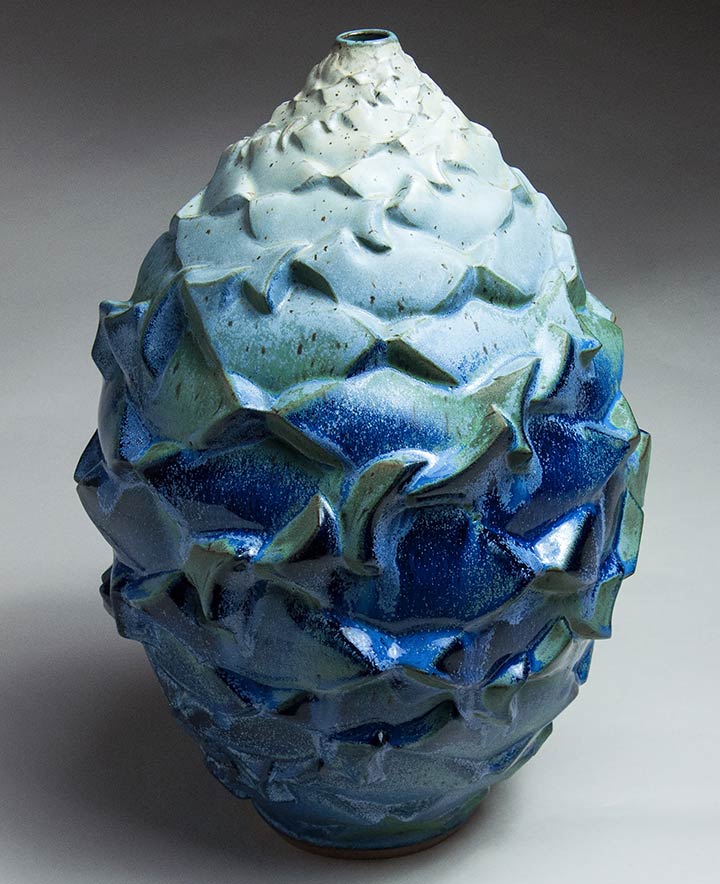
The Function of the Inside
We’re used to thinking of pottery pieces as objects that we use — favorite mugs that fit comfortably in our hands for our morning beverage of choice; bowls for our granola or soup; vases for favorite flowers that decorate our interiors.

At 14.5” height and 10” width at its widest point, “Journey to the Source 3” is a ceramic piece that I completed recently. What is its use? If you look at it, you can see that it has an opening. It is a vessel. Will it hold water? Maybe. Is it a vase? Probably not, though one could poke a few single stems or dried weeds into the top (See Figure 1).
What is a vessel? Vessels hold. If not water, at least they hold air, or emptiness. Imagine this same ceramic piece, but with no opening at the top, a closed oval shape. The piece would be an extroverted object, displacing space and interacting with its environment. Now look at it again with its small opening at the top. The form becomes introverted, self-contained. There’s something that the viewer doesn’t see—the inside. The object has an existential presence connected to its mysterious inner space. It holds something.
Look more closely at this piece and you see that it has a complex, interlocking pattern of repeating shapes that are formed with deep relief, a surface composed of 3-D tessellations. How do I construct these complicated forms? First I throw the piece on a potters wheel. At this stage it looks like any other pot, with a smooth surface. I form them so that they’re a bit narrower than I want them eventually to be, knowing that when I alter them, the form will become a bit wider, especially at the widest part of the vessel. Once the form is leather-hard and trimmed, I draw a grid on the piece, dividing it up horizontally and vertically, sometimes putting in diagonals as well. Sometimes the grid is based on squares, sometimes on a rectangle roughly in the proportions of a golden rectangle. Then I draw my two-dimensional pattern on the grid.
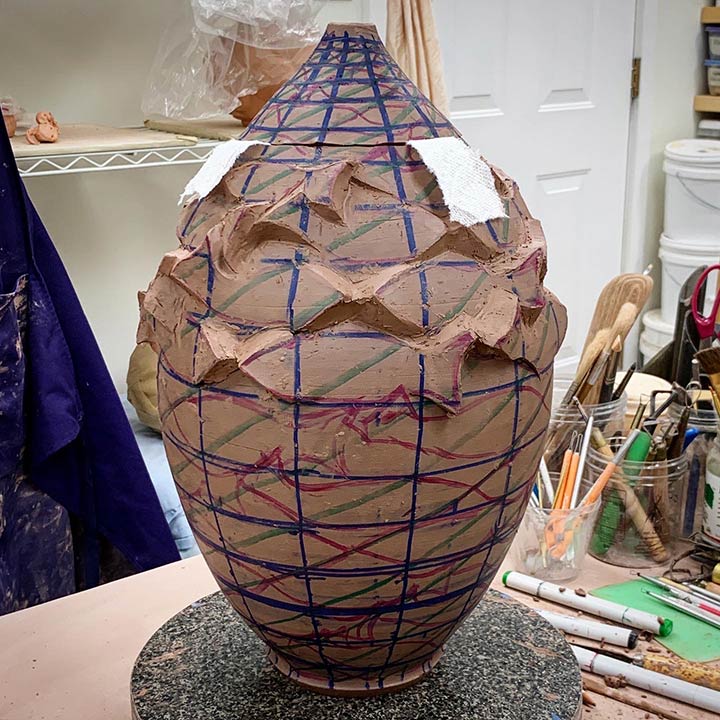
To alter the piece, I need to get my hand inside. So I cut off the top, wrap it up in plastic, and set it aside until I need it again. Then I cut through the wall of the vessel, cutting out parts of each pattern piece, one at a time. Pushing some parts in and some parts out, I change the angles of the various planes in a regular pattern, creating deep relief. This process also creates big gashes and gaps in the wall of the vessel. Taking strips of clay, I fill in the openings, both inside and out, creating new walls as I go along (See Figure 2).
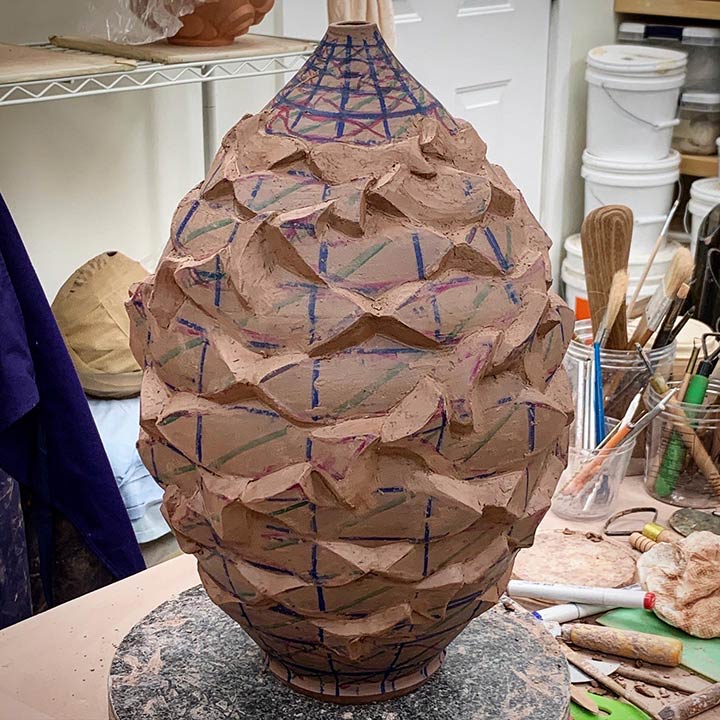
This process continues until almost the entire piece has this repeating pattern. Then I reattach the top. But the top and a bit at the bottom is still smooth, like the original thrown piece. At this point, I cut out little pieces of clay to attach to the top and bottom of the piece in order to continue the 3-D pattern I’ve created on the main body of the vessel. Keep in mind that these attached pattern pieces can be smaller and thinner, since the vessel is getting smaller as it narrows in at the top. I can also augment the relief design by scooping out, or carving into the vessel’s walls (See Figure 3).
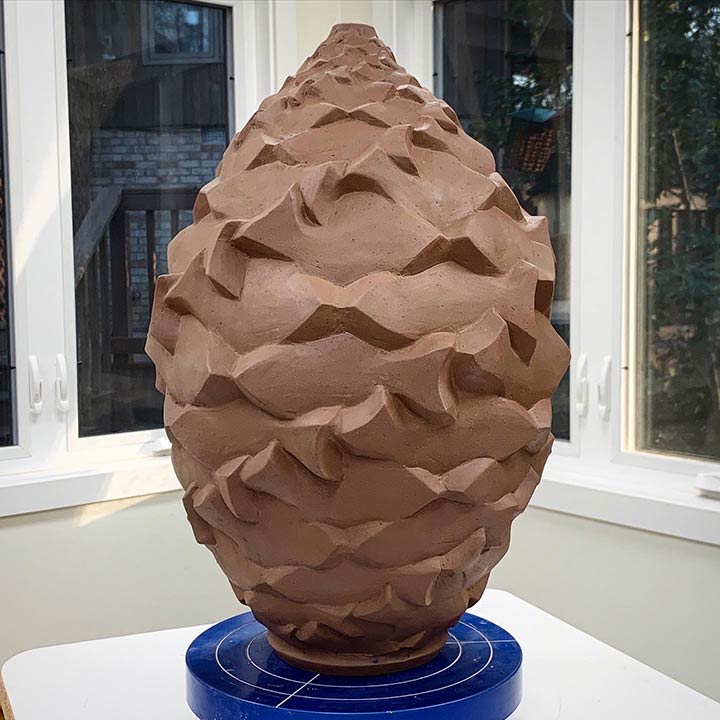
When all of this work is completed, then I carve, shape, and clean up the design. It’s not until this happens that the design starts to take on its character, since the altering process results in a pretty messy look, as you can see in the last image (See Figure 4-video and Figure 5).
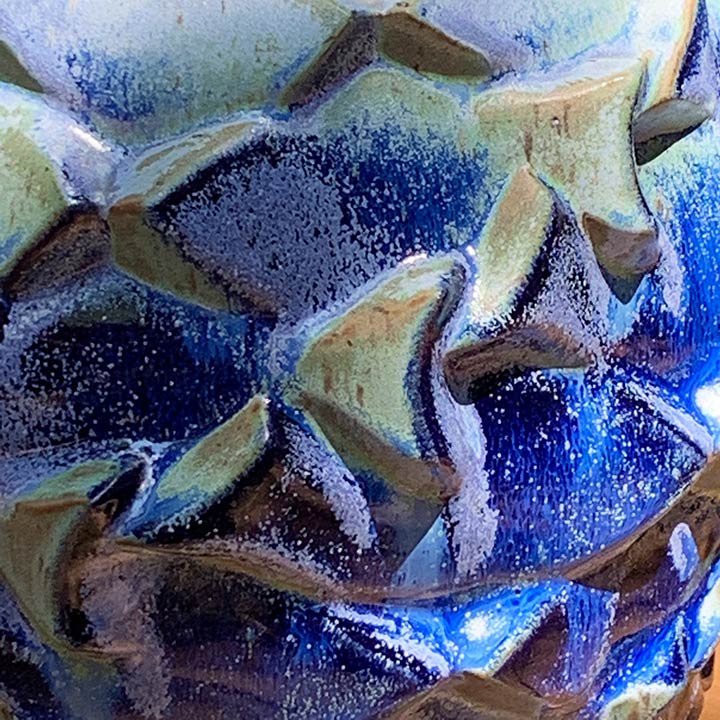
What might these shapes suggest? There’s lots of movement, and if you look at the variations in the glaze colors, they might suggest water, with the darker shades deeper and the lighter shades in the shallows. Can you see the abstracted fish forms flopping, their tails thrashing (See Figure 6)?
I’m originally from the Pacific Northwest, where the migratory runs of salmon and steelhead are so much a part of the traditional folklore, as well as part of the outdoor culture enjoyed there today. The fish start in the headwaters of Pacific streams as eggs, then hatch and make their way as fingerlings to the ocean. There they stay until they’re ready to find their way back to the place of their origin, to the source, to the same coastal stream where they started. There they will reproduce and die.
“Journey to the Source 3” is the third piece that I’ve made using this motif. The first one was made as a receptacle for my father’s ashes. He loved fishing in the beautiful coastal streams in Oregon, so it seemed appropriate to use this visual and conceptual metaphor for this purpose, for his “journey to the source”. So in fact, the first of these pieces did have a function. But really, does it need to hold actual ashes to have a function? I don’t think so.
In the ancient world, vessels were used functionally, but also metaphorically in ritual and literature, employing some of the same ideas of interiority. I treat the metaphor of the inner as a resonant subject matter for ceramic art pieces. Implied are the dichotomies between the inner and outer, the hidden and the seen, the created world and the ineffable mystery. Cutting through the wall and changing the angles of the various connecting planes, I create deep relief, a dynamic movement that leads the eye to the inside of the vessel, opening a dialogue between the vessel’s outer planes and inner spaces.
All of my ceramic work has these ideas as its starting point. Sometimes the pieces are more specifically tied to an idea, like the three versions of “Journey to the Source”. Some just create a movement of the eye up to the top and into the interior. I’m a great admirer of well-made functional pottery at its most basic, for everyday use. But isn’t it time to expand our notion of “function” and allow for some conceptual thinking about the vessel form, about the inside and the outside? Doesn’t that serve the function of conveying meaning, of symbolically holding ideas about humankind, consciousness, and the soul?
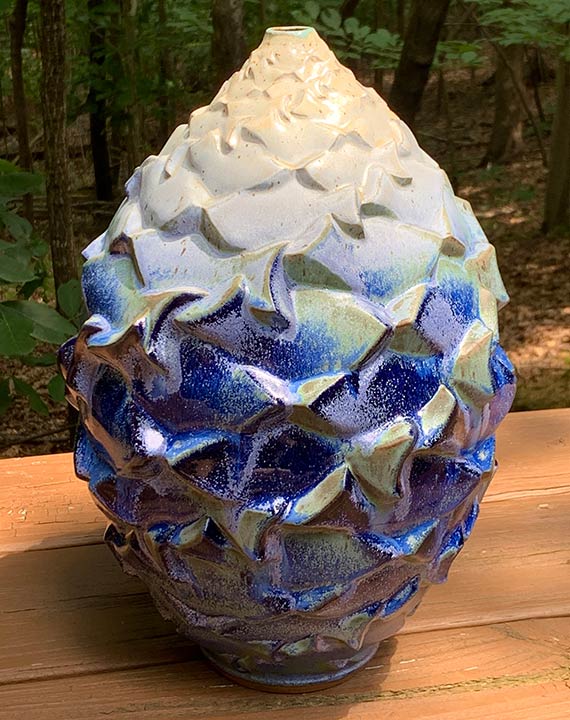
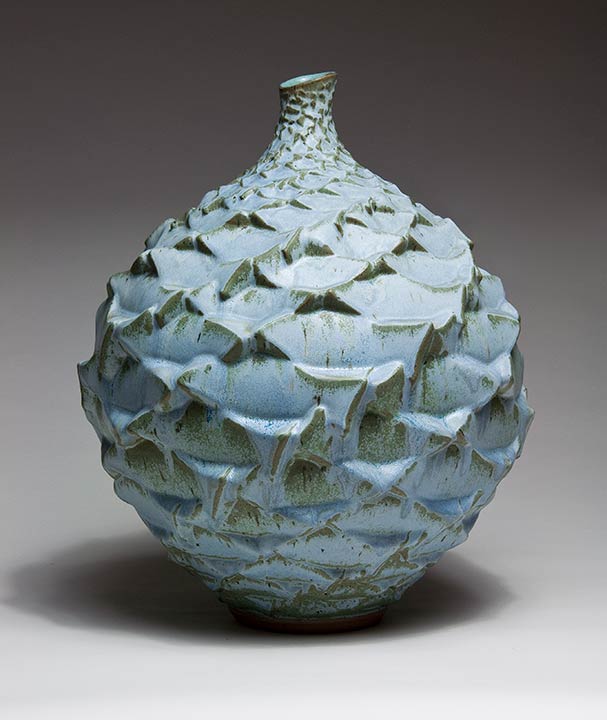
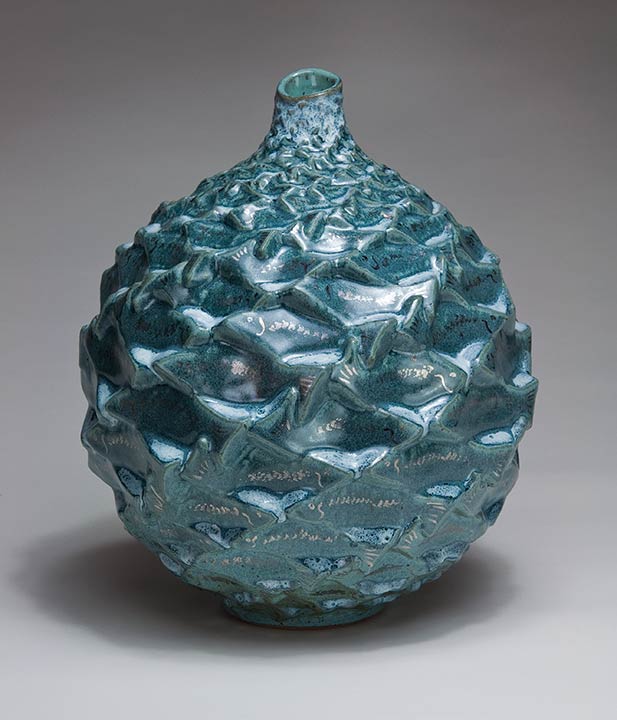
A NOTE ON COLOR:
You’ll notice that this last image of “Journey to the Source 3” has much more purple in it than the first image at the top. It’s extraordinary how differently glazed pieces can look in different light, especially between artificial and strong sunlight. Glazes have a high content of glass, so strong sunlight makes the colors pop. Colors are actually truer to how the eye sees them in strong sunlight, where the whole color spectrum shows. “Journey to the Source 3” has both strong greens and blue/purples, as well as some very dark blues and bright medium blues, and some off-white. Under photo lights and after adjusting the color, the blue/purple tends to disappear. In indoor, dimmer light, though, the piece will look predominantly blue and green, while in strong sunlight, the blue/purples will be more visible. This shot taken with my iPhone in bright sunlight shows this shift in color from the first image at the top, which was taken under photo lights.
